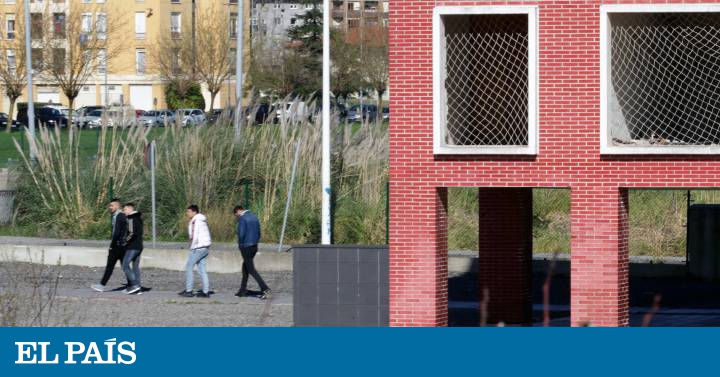"It's like the fence of Melilla, but in Santander," says a neighbor of the Santander fishing district. More than 1,000 kilometers separate the two cities, but they are united by the constant intention of overcoming a border and reaching a life that is better expected. In the port of Santander, groups of migrants, mostly Albanians, sneak in every day to try to access a ship to the United Kingdom. They yearn for the work that neither Spain nor Albania can offer them, and for this they enter port land and then try to get on a ship, something extremely difficult. Until then, they survive with hardly any resources in the city.
The first step seems affordable. A fisherman who bathes earthworms points to a dented sheet metal wall, about two meters high on Sotileza Street. You can surround the flimsy wall, at its limit with the sea, being careful not to fall. Once inside, the odyssey for migrants arrives like an Albanian boy who protects himself from questions with a “ No interviews, no interviews ” [“no interviews”] in abandoned homes five kilometers from the pier. There he resides with 25 compatriots. Soon, the distrustful blue-eyed boy admits that he managed to get into a truck last week. They intercepted him.
Your case is one more. The Port Authority of Santander counted 2,360 interventions of this type in 2019. Last January they added 259. Jaime González, president of the entity, considers the environment “highly vulnerable”, whose security contrasts with the port of Bilbao, which suffered this “problem of intrusion ”until reinforced protection. González affirms that they plan to install a fence of 4.5 meters high and increase the strength of the Civil Guard.
MORE INFORMATION
The ports of Santander and Bilbao will strengthen border controls- Half of the refugees arrived in Germany during the migration crisis find work in five years
- The journey of the baby who was born and died in a patera
The dismantling of the camps in the French port of Calais in 2016 attracted more migrants to the northern peninsula with the United Kingdom as their destination. After closing the Basque track, they went to Cantabria. Ana Uría is one of the lawyers who assists them in the dungeons "in case they want to apply for asylum." A translator helps by phone. The lawyer reports that her defenders access Schengen territory - free internal movement - by road from Hungary and Slovenia, and arrive in Santander. The detainees, he adds, just want to go back to the street: "We don't see them again and they don't communicate." They will continue trying to sneak into the ships.
The companions of the young Albanian with blue eyes, who call that block in the Peña Castillo neighborhood home, are also 18 years old. They do not give names. Boards complete walls without windows to have four walls; a stove and several pans accumulate and dirt prevails. In the background, trap music. That beefy boy who drinks an infusion, the one with gray sneakers and the thinnest one, with a Juventus shirt, left Albania in search of opportunities. They have not arrived yet. The neighbors of the fishing district accuse them of stealing clothes and coats on the clotheslines. Uría explains that they usually carry some money and that they say they stay “in a hostel”, although they never specify where.
Reinforcements will accompany civil guards as an agent who describes, resigned, daily detentions. As soon as they can, the migrants will jump again, especially at night. Some try to sneak in, others must prevent it: “We know each other. In the morning I run through the port, I meet them, they greet and ask if I work today ”. They also use stairs "or form castellets" to overcome raised walls.
Violations have contributed to Brittany Ferries, whose ships docked in Santander from the Irish Cork, decide to moor in Bilbao. And the problem with stowaways splashes all the companies in the port. Sources from the Cantabrian Government Industry area point out that the human presence between goods such as food or clothing causes them to be thrown away or returned, with the consequent losses.
The groups have organized through the port of Santander to know the weak sections. They are coordinated thanks to the Wi-Fi and plugs of the Jardines de Pereda, near the pier. They frequent nearby supermarkets. One of the riskiest tactics is explained by a port worker: some migrants take advantage of the low tide to circumvent the wooden structures under the pier and climb to the surface, force a truck and get in. A South American worker empathizes from the scaffolding: "In this life you try everything until you can."

